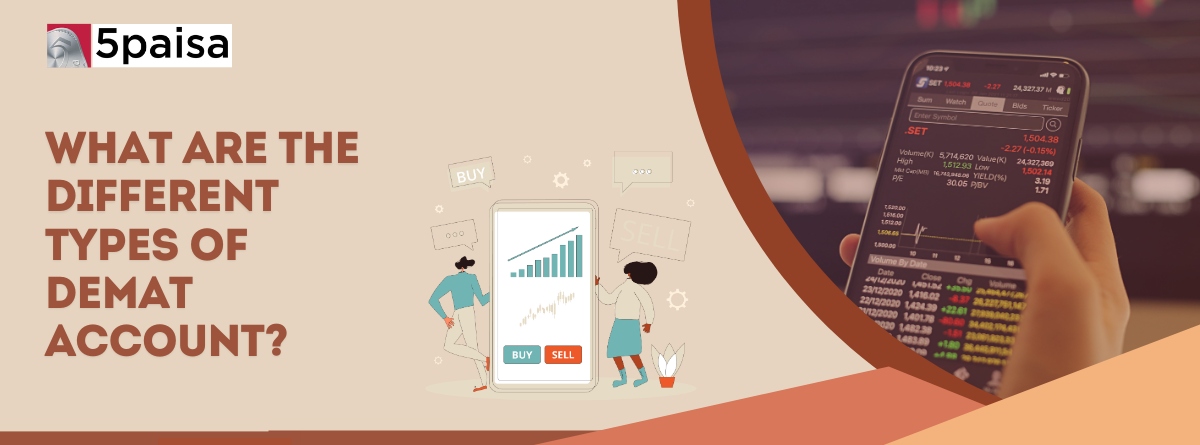Content
- Different Types of Demat Accounts in India
- What are the documents required for opening all types of Demat Accounts?
- Is a Demat account mandatory for Trading or Investing?
- How to pick the right type of Demat Account?
- Conclusion
Before choosing the most suitable type of Demat account for you, you need first understand what is a Demat account?. A Demat account, also known as a Dematerialised account, is a type of account that holds and records your shares and securities. It is mandated by the Securities and Exchange Board of India (SEBI).
You don't physically hold paper certificates for your investments when you have a Demat account, and all of your ownership and transactions are documented electronically. You manage the Demat account with the assistance of a Depository Participant, who works as an intermediary between you and the depository.
There are certain fees associated with having a Demat account, although they are usually minimal. These charges can include a fee for opening a Demat account, an Annual Maintenance Charge (AMC) to keep it active, a custodian fee for safekeeping your securities, and a transaction fee for buying or selling securities.
More Articles to Explore
- Difference between NSDL and CDSL
- Lowest brokerage charges in India for online trading
- How to find your demat account number using PAN card
- What are bonus shares and how do they work?
- How to transfer shares from one demat account to another?
- What is BO ID?
- Open demat account without a PAN card - a complete guide
- What are DP charges?
- What is DP ID in a demat account
- How to transfer money from demat account to bank account
Disclaimer: Investment in securities market are subject to market risks, read all the related documents carefully before investing. For detailed disclaimer please Click here.
Frequently Asked Questions
The benefits of using the different types of Demat accounts in India include the following:
● You can hold securities and shares in an electronic format.
● You can conduct fast and instant security transfers.
● You will be able to eliminate ‘bad deliveries.’
● It allows quick disbursement and settlement of Corporate perks like dividends, bonuses, etc.
● There will be risk elimination by mutilation, theft, loss, etc.
Two popular types of demat accounts in India are repatriable and non-repatriable accounts. Compared to non-repatriable accounts, repatriable ones enable NRIs to transfer their hard-earned funds or money abroad. However, if any NRI invests in mutual funds via an NRO (Non-Resident Ordinary) account, their income from such mutual funds investment will be non-repatriable.
Yes, the different types of demat accounts are mandatory, only under certain circumstances. Having a demat account is mandatory only when you plan to invest in stocks and no other type of security. Although a demat account isn’t mandatory to invest in mutual funds, having access to one can simplify things for you.
A 3-in-1 demat account is one of the most popular types of demat account, which is a combination of a demat, trading, and bank account. This allows individuals to store and save their own funds via savings account, buy or sell securities via trading account, and store those securities via demat account.
For most resident Indian investors, a Regular Demat Account linked to NSDL or CDSL is the best option. It offers flexibility, ease of use, and is suitable for holding shares, bonds, ETFs, and mutual funds.
NRIs can choose between NRE (Non-Resident External) Demat Accounts for investments with repatriable funds and NRO (Non-Resident Ordinary) Demat Accounts for investments made using income earned in India. The choice depends on whether you need to repatriate funds abroad or keep them within India.
Beginners usually prefer a Basic Services Demat Account (BSDA). It has lower maintenance costs, making it ideal for small investors who are just starting out and don’t plan to hold large portfolios initially.
Yes. Charges differ based on the type of account and the service provider. For example, BSDA accounts have reduced annual maintenance charges, while NRI accounts may have higher fees due to compliance requirements. Regular demat accounts usually carry standard brokerage and maintenance charges.




